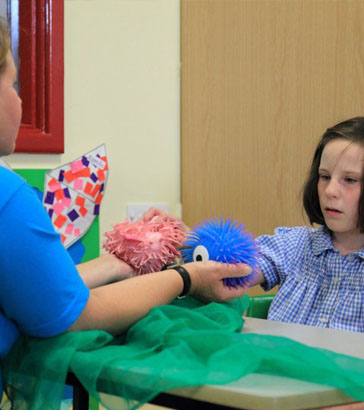in choices (1)

Ascertaining the views of children with SLD/PMLD/CLDD can be
challenging, but is a high priority if we are to place the children
at the centre of planning and give them choice and control wherever possible.
The 'Involve Me' project (Mencap/British Institute of Learning Disabilities, 2011) and the Choice Initiative (Foundation for
People with Learning Disabilities,
2000) give guidance on how to involve people with PMLD in
choices, decisions and consultations.
choices (2)

Murray and Osborne (Department for Children, Families and Schools, 2009)
advocate '...a strong culture of consulting with, listening to and encouraging
the participation of disabled children amongst all services... In order
for disabled children to participate in decisions about their safety and
welfare, it is essential that resources and time are made available to allow
their voice to be heard.'
For more information on communication, see the modules Communication
and interaction and Communication: augmentative and assistive strategies.

...all disabled children can communicate, and the people working with them should find ways of enabling them to do so.
Lenehan et al, 2004
...disempowering disabled children in quite small, unintentional ways, may silence them.
PW Threlfall Training & Consultancy, 2010
Listening to pupils (1)
-
 A headteacher0:55talks about listening to pupils
A headteacher0:55talks about listening to pupils -
 A teacher1:39talks about listening to pupils
A teacher1:39talks about listening to pupils
Listen to the headteacher and teacher talking about listening to pupils and read the documents on the next slide.

Identify the key points about choice-making made in these documents and in the audio clips.
Compare your ideas with this sample answer.
The Mental Capacity Act 2005 is clear that everything that is done
for or on behalf of a person who lacks capacity must be in that person's
best interests.
British Institute of Learning Disabilities, 2008
In the past, people have been confused about when and how to make decisions
for people with profound and multiple learning disabilities (PMLD).
The Mental Capacity Act 2005 puts into law the rights of people who lack
capacity to make their own decisions, as well as those who can make their
own decisions.
Mencap, undated
decision-making checklist

- Consider relevant circumstances.
- Make every effort to encourage the person to take part in the decision.
- Consider if the person is likely to regain capacity.
- Take the person's past and present wishes, feelings, beliefs and values into account.
- Take into account the views of the people close to the person.
It is becoming more and more apparent that using circles of support is one of the best ways of assisting a person with PMLD to get the right support and have control over their lives.
Many circles include family members, friends and, sometimes, staff who know the individual well... By using those people already known to the person as a resource, services and agencies are able to get a clearer, truer picture of who the individual is and what their goals and support needs are.
PMLD Network, 2002
Giving pupils choice
Watch the interactions in these clips, and consider what strategies staff are using to give pupils choice in their environment and personal care.
-
 Clip 11:53A teacher asks a pupil with PMLD to choose a snack and a drink using symbols.
Clip 11:53A teacher asks a pupil with PMLD to choose a snack and a drink using symbols. -
 Clip 21:22A teacher and pupil converse about adults who provide personal care
Clip 21:22A teacher and pupil converse about adults who provide personal care

The 'Involve Me' project (Mencap/British Institute of Learning Disabilities, 2011) gives guidance on how to involve people
with profound and multiple learning disabilities (PMLD) in
decision-making and consultation.
For videos and a practical guide, visit:

The Choice Initiative (Foundation for People with Learning Disabilities,
2000), a programme of five innovative projects, explored how people with
severe, profound and multiple learning disabilities, can express choices
and take more control over their own lives.
For information, visit:

The projects on the previous pages, and others relating to people with PMLD,
are listed on the PMLD Network website:

